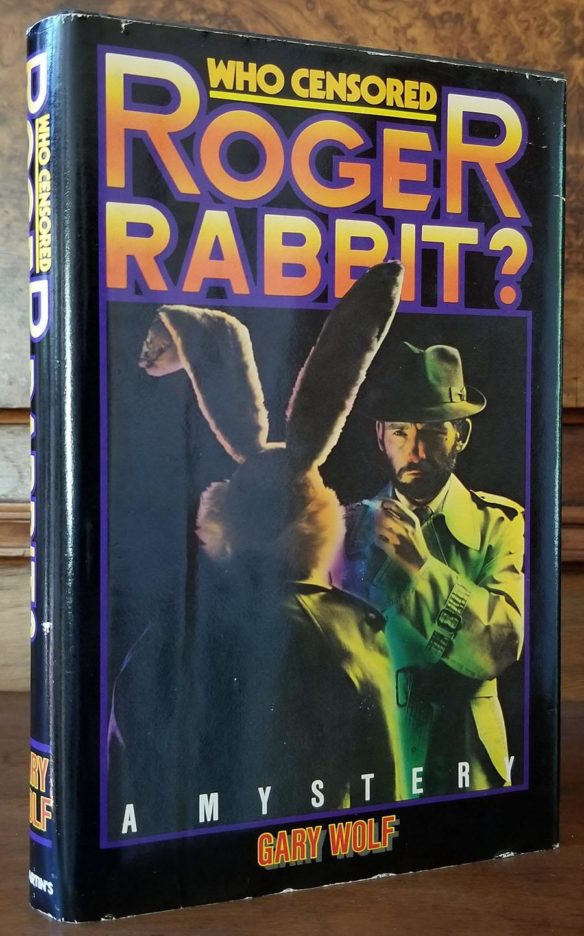(1) CLOSE ENOUGH FOR…WHAT KIND OF WORK? Ted Chiang tells The New Yorker that “ChatGPT Is a Blurry JPEG of the Web”.
… This analogy to lossy compression is not just a way to understand ChatGPT’s facility at repackaging information found on the Web by using different words. It’s also a way to understand the “hallucinations,” or nonsensical answers to factual questions, to which large language models such as ChatGPT are all too prone. These hallucinations are compression artifacts, but—like the incorrect labels generated by the Xerox photocopier—they are plausible enough that identifying them requires comparing them against the originals, which in this case means either the Web or our own knowledge of the world. When we think about them this way, such hallucinations are anything but surprising; if a compression algorithm is designed to reconstruct text after ninety-nine per cent of the original has been discarded, we should expect that significant portions of what it generates will be entirely fabricated.
This analogy makes even more sense when we remember that a common technique used by lossy compression algorithms is interpolation—that is, estimating what’s missing by looking at what’s on either side of the gap. When an image program is displaying a photo and has to reconstruct a pixel that was lost during the compression process, it looks at the nearby pixels and calculates the average. This is what ChatGPT does when it’s prompted to describe, say, losing a sock in the dryer using the style of the Declaration of Independence: it is taking two points in “lexical space” and generating the text that would occupy the location between them. (“When in the Course of human events, it becomes necessary for one to separate his garments from their mates, in order to maintain the cleanliness and order thereof. . . .”) ChatGPT is so good at this form of interpolation that people find it entertaining: they’ve discovered a “blur” tool for paragraphs instead of photos, and are having a blast playing with it….
(2) ARGUMENT FOR SEPARATING ART AND THE ARTIST. [Item by Bruce D. Arthurs.] EV Knight, doctor, says she was dumped from a hospital position due to writing horror. There is further information in Knight’s response to comments.
(3) ATTENDING LTUE THOUGHTFULLY. At Being A Better Writer, Max Florschutz encourages writers attending LTUE to focus on the opportunity to learn more about their craft and not just bask in the reflected glory of celebrity authors: “How to Use a Writing Resource Like LTUE”.
…LTUE, Life, The Universe, and Everything, which is the writing convention for writers, is happening this week. It’s a big deal. I’ve been readying myself for several weeks now, making sure that I’m prepared and ready to go when this Thursday rolls around….
See, there’s a lot that goes on at LTUE, but one thing that people sometimes forget when they’re in attendance is that first and foremost, LTUE is an educational con. Yes, it’s neat and fun to be able to meet some of our favorite authors and creators in the Sci-Fi and Fantasy space … but we’re not there just to meet them. And when they bring up that book that you really love or that scene that you thought was very cool, they’re not just brining it up because of that—though they definitely love it too. No, they’re bringing it up because they want to illustrate a point, or demonstrate something….
He follows with a checklist to use in assessing which items to attend. It’s advice you could adapt for attending many different cons.
(4) AMAZING’S NEW EDITOR. Lloyd Penney is a news flash on the Toronto Metropolitan University School of Journalism webpage: “Alum named editor of sci-fi magazine Amazing Stories”.

When Lloyd Penney ‘83 received a phone call last November, he was not expecting to hear surprising news. He says he was utterly shocked to find out he would be the next editor-in-chief for one of America’s most popular sci-fi magazines, Amazing Stories, external link.
Penney describes Amazing Stories as the “best writing” of science fiction that is enjoyable to read.
“Some of them can be bizarre, but that’s the expression of imagination. And if you can think it, if you can imagine it, you can grasp it,” says Penney.
Published for almost a century, the idea of Amazing Stories is to challenge you to think the unthinkable, enhance your imagination and enjoy the writing.
“Now, one of my jobs, besides being the editor-in-chief, is also the defender of that long history. I want to make sure that we do right by it,” says Penney….
(5) STICKING TO IT. Jon Favreau now has a star on the Hollywood Walk of Fame. The actor he cast as Iron Man introduced him in Tony Stark style. “Watch: Robert Downey Jr. Honors Jon Favreau by Defiling His Walk of Fame Star With Chewed Gum” at Comicbook.com.
…Downey took the podium to pay tribute to his two-time Iron Man director, who lobbied producer Kevin Feige and Marvel Studios to cast the once-troubled actor at the time better known for his off-screen bad behavior than his movie career. (“It wasn’t an easy job to get him cast,” Favreau recalled to EW in 2018. “There was quite a bit of resistance at first.”)
“Never forget where you come from. 16 years ago this week, Jon and I were in pre-production on what felt like a high-concept indie, and we were fueled by this infectious, yet unfounded, confidence,” Downey said in his speech. “I was beyond grateful for the power of second chances. Strangely, Kevin Feige trusted us, he and I trusted Jon, and for no good reason, Jon and Kevin trusted me.”
Before Iron Man grossed more than half a billion dollars globally and kick-started the now 31-movie MCU, it was “a second-tier superhero property that had no shot at affording Kevin Feige the opportunity to launch a cinematic universe, because there was no such thing as a cinematic universe.”
“Now, I would never insinuate that it was me who made Jon a multi-hyphenate international sensation, because I have to leave something for his speech,” Downey quipped, breaking out in laughter. “And there’s nothing more awkward for my friend that we are here to celebrate and honor than being honored and celebrated.”…
(6) MEMORY LANE.
1981 – [Compiled by Cat Eldridge.]
I suspect that almost all of you here have seen the Who Framed Roger Rabbit? film. Brilliant I think we can all agree. The screenplay was by Jeffrey Price and Peter S. Seaman which they based off of Gary K. Wolf’s Who Censored Roger Rabbit? novel.
Now how many of you have read the Who Censored Roger Rabbit novel? Well I have. It actually reads rather well. It of course is an entirely different experience than the film but a rather excellent one none the less. The characters are well fleshed out, the setting is described quite well and the story which more or less makes it intact to Who Framed Roger Rabbit? is quite good.
And now here is that Beginning…
I found the bungalow and rang the bell.
My client answered the door. Novel.
He was almost my height, close to six feet, but only if you counted his eighteen-inch ears. He wore only a baggy pair of shorts, held up by brightly colored suspenders. His shoulders stooped so badly, he had to secure his suspender tops in place with crossed pieces of cellophane tape. For eyes, he had twin black dots, floating in the center of two oblong white saucers. His white stomach, nose, toes, and palms on a light brown body made him resemble someone who had just walked face first into a freshly painted wall.
“I’m Eddie Valiant, private eye. You the one who called?”
“Yes, I am,” he said, extending a fuzzy white paw. “I’m Roger Rabbit.” His words came out encased in a balloon that floated over his head.
The rabbit ushered me into his living room. The angular furniture reminded me of the upward-reaching spires in caves. That, combined with an extremely low ceiling and stale air, gave the room the closed-in nature of an underground burrow. Perfect interior design for a rabbit.”

(7) TODAY’S BIRTHDAYS.
[Compiled by Cat Eldridge.]
- Born February 14, 1919 — David A. Kyle. He chaired the 1956 Worldcon, was a leader in First Fandom, and wrote innumerable fanhistorical articles for Mimosa. Along with Martin Greenberg, he founded Gnome Press in the late Forties. He also penned two illustrated SF histories, A Pictorial History of Science Fiction and The Illustrated Book of Science Fiction Ideas and Dreams. He wrote three novels set in the Lensman universe: The Dragon Lensman, Lensman from Rigel and Z-Lensman. So has anybody read these? (Died 2016.)
- Born February 14, 1925 — J. T. McIntosh. Scottish writer at his best according to Clute in his early work such as World Out of Mind and One in Three Hundred. He’s deeply stocked at the usual suspects at very reasonable rates, indeed most as Meredith Moments. (Died 2008.)
- Born February 14, 1933 — Robert Shea. Author with Robert Anton Wilson of The Illuminatus Trilogy (The Eye in the Pyramid, The Golden Apple and Leviathan). Is it really genre? Or just the ravings of two insane writers? It won the Prometheus Hall of Fame Award. (Died 1994.)
- Born February 14, 1942 — Andrew Robinson, 81. Elim Garak on Deep Space Nine. He wrote a novel based based on his character, A Stitch in Time and a novella, “The Calling” which can be found in Prophecy and Change, a DS9 anthology edited by Marco Palmieri. Other genre credits include Larry Cotton in Hellraiser, appearing in The Puppet Masters as Hawthorne and playing John F. Kennedy on the The New Twilight Zone.
- Born February 14, 1952 — Gwyneth Jones, 71. Interesting person that she is, let’s start with her thoughts on thoughts on chestnuts. Just because I can. Now regarding her fiction, I’d strongly recommend her Bold As Love series of a Britain that went to pieces, and her twenty year-old Deconstructing the Starships: Science, Fiction and Reality polemic is still worth reading.
- Born February 14, 1952 — Paula M. Block, 71. Star Trek author and editor; but primarily known for working in Paramount Pictures’ consumer licensing division and then with CBS Consumer Products. Remember that novel I noted by Andrew Robinson? Yeah that’s her bailiwick. She’s also written with her husband Terry J. Erdmann, Star Trek: Deep Space Nine Companion and Star Trek: Costumes: Five Decades of Fashion from the Final Frontier. It looks like she did some Trek fanfic as well including “The Girl Who Controlled Gene Kelly’s Feet”.
- Born February 14, 1963 — Enrico Colantoni, 60. Any excuse to mention Galaxy Quest is one I’ll gladly take. He played a delightful Mathesar on that film and that was his first genre role, lucky bastard. up next for him was A.I. Artificial Intelligence as The Murderer followed by appearing in Justice League Dark as the voice of Felix Faust where (SPOILER!) his fate was very, very bad. He had an amazing role on Person of Interest as Charlie Burton / Carl Elias. Not genre, but his acting as Sgt. Gregory Parker on Flashpoint, a Canadian police drama television series is worth noting
- Born February 14, 1975 — M. Darusha Wehm, 48. New Zealand resident writer who was nominated for the Nebula Award and won the New Zealand Sir Julius Vogel Award for The Martian Job novel. She says it’s interactive fiction. You can read the standalone prequel novella, Retaking Elysium, on her website which can be found here.
(8) COMICS SECTION.
- Sally Forth shows someone inventing an entertaining board game mashup.
(9) JEOPARDY! David Goldfarb chronicled two sff references in yesterday’s episode of Jeopardy!
TV Catchphrases, $200: “This Starfleet captain: ‘Make it so'”
The returning champion, Mira Hayward, tried “Who is Captain Kirk?”.
Jeff Paine responded correctly.
TV Catchphrases, $1000: “Mork: This double-talk Orkan signoff”
Jeff Paine (who looked a bit young to have watched it on first run) responded “Nanu nanu”. He hails from Colorado Springs, so perhaps the Colorado connection helped.
(10) VERDICT APPEALED. [Item by Mike Kennedy.] Some little time back, Warner Bros. Discovery executives leaked that they axed the Batgirl film, which was well into post production, because, well, it sucked. “Not so!” says the title actress, Leslie Grace. “‘Batgirl’ Star Leslie Grace Rejects Studio’s Claim the Axed Film Was Unreleasable: The Cut I Saw Was ‘Incredible’” in Variety.
When “Batgirl” completed its seven-month production in Scotland, star Leslie Grace received a wrap gift from Brendan Fraser, who played her nemesis, Firefly, in the DC movie — a gold necklace that included two charms, a little bell and a pair of dice.
“The card said a lot of really sweet things, but he basically said, ‘I give you this necklace because in this business you gotta have a little luck. So ring your bell and never stop,’” Grace says. “It was just like, Whoa. And after all this, it’s had so much meaning.”
“All this” is the August bombshell that Warner Bros. Discovery had decided to kill the film, co-directed by Adil El Arbi and Bilall Fallah. After the first disappointing test screenings, WBD executives chose to take a tax write-off instead of trying to complete work on the film, which had cost the debt-ridden studio $90 million, and would have cost many more millions to finish.
Grace says she had no idea the movie, originally set to stream on HBO Max, was shelved, until it was first reported by the New York Post.
“I found out like the rest of you,” she says. “And then my phone just started blowing up.”
Like Grace, Fraser says he was blindsided by the news. “I thought I was getting punked, but it checked out,” he says of reading the initial stories. “Then came hysterical laughter like, ‘You’ve got to be kidding me?’ I know that the filmmakers and producers were expecting to hear from the studio about the film, and the anticipation was, ‘How do we broaden the movie out to take it from a streaming format to a theatrical release?’ But as we all know, it was the complete opposite. When we were expecting XYZ amount of support and money to expand scenes — to do pickup shots and those kinds of things — that was a gut punch. But then we learned that it was in the interest of writing down some debt? That part really stung.”
Fraser immediately called Grace. “What I find most lamentable is that now a whole generation of little girls are going to have to wait longer to see a Batgirl and say, ‘Hey, she looks like me,’” he says. “That makes me sad. I know how good she was. And I know what this would mean to so many people.”
Fraser gets emotional talking about working with Grace. “It was just magical to see how she was as quietly confident as a young actress in this breakthrough role and had a sense of purpose and dignity,” he says. “She has a work ethic that is unrivaled. She’s dynamite — and dynamite comes in small packages but still goes bang. We do battle each other several times. There was a lot of kicking and punching and getting hurt but we were always help each other to our feet after breaking set pieces and knocking the tar out of each other.”…
(11) A SPOKE IN SPACE. [Item by SF Concatenation’s Jonathan Cowie.] Research in the journal Geophysical Research Letters highlights the start of a change in Saturn’s rings. “Hubble Detects the Start of a New Saturn Ring Spoke Season”.
Saturn is known for its iconic, pristine rings. However, the main B ring can have splotches and streaks of darker or lighter material, known as spokes, that may be tied to dust interactions with the planet’s magnetic field. These spokes appear periodically, lasting around 8 years, centered around Saturn spring or fall equinox. Hubble Space Telescope observations in 2021 and 2022 revealed the start of a new ring spoke season in advance of the next equinox in 2025. Multi-color observations reveal a reddish color, and that the spokes circle the planet at about the same rate as the ring particles, though perhaps influenced by the variable rotation rate of Saturn’s magnetosphere. Spoke activity should continue to increase for the next several years, becoming more visible to ground-based telescopes over time.

(12) VIDEO OF THE DAY. In Fabrice Mathieu’s “In the shadow”, a shadow is telling its life story with his “Wearer”, a flesh and bone double, who one day it decides to get rid of…
This prequel is a research and editing work based on footage from more than sixty movies showing the most beautiful shadows in the cinema history, from “Nosferatu” to “Sin City”. The story is narrated from the shadow’s point of view.
[Thanks to Cat Eldridge, Mike Kennedy, John King Tarpinian, Bruce D. Arthurs, Daniel Dern, SF Concatenation’s Jonathan Cowie, David Goldfarb, Lloyd Penney, Fabrice Mathieu, Chris Barkley, Andrew Porter, and Michael Toman for some of these stories. Title credit belongs to File 770 contributing editor of the day Cat Eldridge.]
